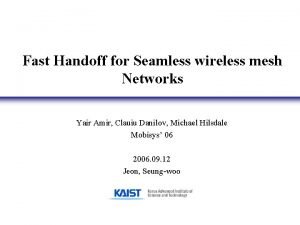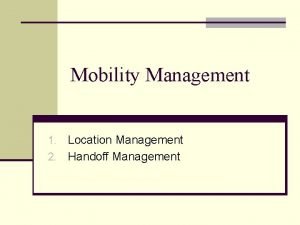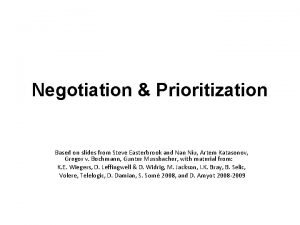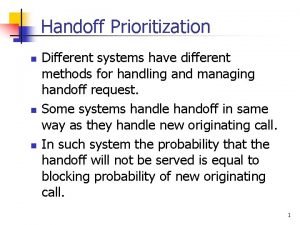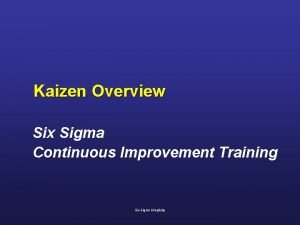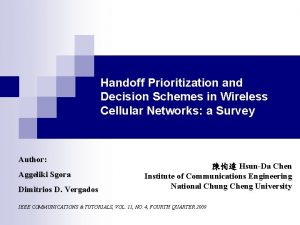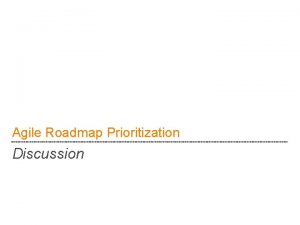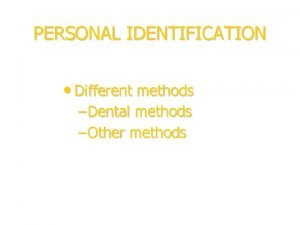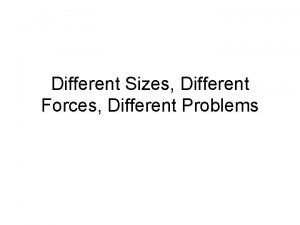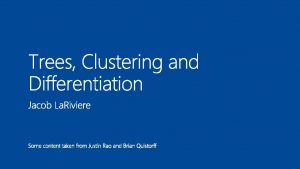Handoff Prioritization n Different systems have different methods





















- Slides: 21

Handoff Prioritization n Different systems have different methods for handling and managing handoff request. Some systems handle handoff in same way as they handle new originating call. In such system the probability that the handoff will not be served is equal to blocking probability of new originating call. 1

Continued. . n n But, if the call is terminated abruptly in the middle of conversation then it is more annoying than the new originating call being blocked. So, In order to avoid this abrupt termination of ongoing call handoff request should be given priority to new call this is called as handoff prioritization. 2

Continued. . There are two techniques for Handoff Prioritization. 1) Guard Channel Concept: In this technique, a fraction of the total available channel in a cell is reserved entirely for handoff request from ongoing calls which may be handed off into the cell. n 3

Continued. . 2) Queuing: Queuing of handoffs is possible because there is a finite time interval between the time the received signal level drops below handoff threshold and the time the call is terminated due to insufficient signal level. The interval size is determined from the traffic pattern of a particular service area. 4

Cellular networks: Handover Classes: • Intra-cell: switch-over inside the cell onto other channel • Inter-cell: switch-over to a neighboring cell • Inter-system: switch-over between different technologies Example: 2 G to 3 G 15 5

Continued. . Handover Types: Hard handover: active connection gets disconnected before the connection to a new cell is established n Soft handover: active connection gets disconnected after the connection to a new cell is established n 6

Dwell time n n Time over which a call may be maintained within a cell, without hand-off. Each base station constantly monitors the signal strength of all its reverse voice channels to determine the location of each mobile user with respect to the base station tower. 7

Mobile Assisted Hand-off (MAHO): A mobile assisted handoff (MAHO) is a process used in GSM cellular networks where a mobile phone assists/helps the cellular base station to transfer a call to another base station. It is a technique used in mobile telecom to transfer a mobile phone to a new radio channel with stronger signal strength and improved channel quality. Mobile assisted handoff can also be referred to as mobile assisted handover. 8

Interference and System Capacity Major limiting factor in performance of cellular radio systems Two main types: n n Co-channel interference Adjacent channel interference 9

Path Loss Exponent “n” This term is commonly used in wireless communications and signal propagation. Path loss may be due to many impurities like reflection, refraction, diffraction, absorption. Path loss is also influenced by terrain/landscape, propagation medium, the distance between the transmitter and receiver and height of the location of antennas. It is denoted by “n”. 10

Co-channel Reuse Factor n n The co-channel reuse factor is D/R (sometimes also referred as Q), is defined as the ratio of the co-channel reuse distance “D” between cells using the same set of carrier frequencies and the radius of the cell “R”. For hexagonal cells, the reuse cluster size “N” and the co-channel reuse factor “D/R” are related by: 11

Signal to Interference Ratio 12

For a hexagonal geometry D / R = (3 N) (Co-Channel Reuse ratio) S / I = [ (3 N) ] n / io 13

Example 14

Solution 15

Trunking and Grade of Service n n Cellular radio system relies on trunking to accommodate a large number of users in a limited radio spectrum Trunking: Each user is allocated a channel on a per-call basis; and upon termination of the call, the previously occupied channel is immediately returned to the pool of available channels 16

Continued… n n n The concept of Trunking allows a large number of users to share the relatively small number of channels in a cell by providing access to each user, on demand, from a pool of available channels. The telephone company uses Trunking theory to determine the number of channels in a cluster that need to be allocated for specific area, and this same principle is used in designing cellular radio systems. One Erlang represents the amount of traffic intensity carried by a channel that is completely occupied. 17

Continued… n n The Grade of Service (GOS) is a measure of the ability of a user to access a trunked system during the busiest hour. It is the wireless designer’s job to estimate the maximum required capacity and to allocate the proper number of channels in order to meet the GOS. 18

Continued… Definitions of important parameters: Ø H is the average duration of a call is the average number of call requests per unit A is the total intensity traffic Ø Set-up time is the time required to allocate a trunked radio channel Ø Blocked Call means a call cannot be completed at time of request, Ø Ø to a requesting user. due to congestion. Ø Load is the traffic intensity across the entire trunked radio system, measured in Erlang (denoted by lemda). Ø Erlang B is a measure of congestion which is specified as the probability of a call being blocked Ø Erlang C is a measure of congestion which is specified as the 19 probability of a call being delayed beyond a certain amount of time

Continued… n n There are two types of trunked radio systems. The first type offers no queuing for call requests, and this type of trunking is called Blocked Calls Cleared (BCC) or Lost Calls Cleared (LCC). “Erlang B” formula is used to indicate the GOS of BCC system. The second kind of trunked system is called Blocked Calls Delayed (BCD) or Lost Calls Delayed (LCD), and its measure of GOS is defined as the probability that a call is blocked after waiting specific length of time in the queue. “Erlang C” formula is used to indicate the GOS of BCD system. 20

Blocked Calls Cleared System n No queuing for call requests If no channels are available, the requesting user is blocked without access and is free to try again later. n 21
 Mesh wifi handoff
Mesh wifi handoff Ipass teamstepps
Ipass teamstepps Network controlled handoff
Network controlled handoff 5 p's of patient handoff
5 p's of patient handoff Project intake process presentation
Project intake process presentation Rpa prioritization matrix
Rpa prioritization matrix Vulnerability priority rating (vpr)
Vulnerability priority rating (vpr) Damian2005 trick
Damian2005 trick Wsjf risk reduction
Wsjf risk reduction Delegation model
Delegation model Risk management software engineering
Risk management software engineering Abcd prioritization nursing
Abcd prioritization nursing Prioritization
Prioritization Prioritization
Prioritization Ticket prioritization
Ticket prioritization Program prioritization process
Program prioritization process Kaizen alternatives
Kaizen alternatives Why do different polymers have different properties?
Why do different polymers have different properties? What is cultural relativism
What is cultural relativism Manufactured boards examples
Manufactured boards examples 8 faces and 6 vertices
8 faces and 6 vertices Direct wax pattern
Direct wax pattern
